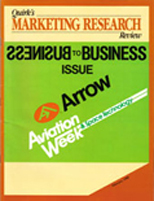For a telecommunications company which ran an advertising schedule in Aviation Week & Space Technology, the awareness among the magazine's subscribers increased 64%.
This was the major finding of a recent study in which familiarity with the company's name was measured both before any advertising appeared in Aviation Week and six months after the campaign began. Aviation Week, which is edited for professionals in aviation, air transportation, aerospace, and advanced and related technologies, is published by McGraw-Hill Inc., New York, one of the country's largest publishers of business magazines.
The market's perceptions
The major purpose of the advertising campaign was aimed at increasing the awareness of the satellite telecommunications company's name, a company whose target market reads Aviation Week, says Bertha A. Chase, director of research and communications for the weekly magazine.
"It was a new company and it wanted to get some feedback from people in its industry and find out how it was recognized and perceived by the readers with its advertising."
According to Chase, it was the company's initial reluctance to advertise in the magazine which prompted Chase's research department to conduct the study. With McGraw- Hill research covering the costs of doing the project, the telecommunications company assumed the cost of producing a single page, four-color ad. The ad appeared in the following 10 issues of the magazine: Oct. 27, 1986; Nov. 10, 1986; Nov. 24, 1986; Dec. 8, 1986; Jan. 5, 1987; Jan. 12, 1987; Feb. 2, 1987; Feb. 16, 1987; Mar. 9, 1987; and Mar. 23, 1987.
During the six-month period, the same advertisement also ran at a lower frequency in publications other than Aviation Week. Five pages were placed in "publication A" and three pages in "publication B."
Methodology
Two direct-mail surveys, one before the advertising schedule ran and the other after it ran, were conducted. The purpose of the benchmark (before) survey was to determine subscribers' familiarity with the company prior to the advertising campaign in Aviation Week. The second survey was conducted to measure changes in awareness of the magazine's subscribers toward the company.
Each survey was conducted among a random sample of 750 Aviation Week subscribers in private industry, the government and the military. A total of 257 returns (a 38% response rate) were received from the first survey and 330 returns (a 44% response rate) were received from the second survey.
While most direct-mail surveys include an incentive to help boost response rates, the Aviation Week study did not because government and military employees are not allowed to accept incentives. Nevertheless, the study obtained a high rate of returns and Chase attributes this to the magazine's name on the letterhead and the respondent's knowledge that the survey was legitimate.
The close-ended questionnaire, the same for both surveys, asked respondents two things: "How familiar are you with a division of (company)?", and "Based on your personal knowledge or impressions, please indicate how strongly you agree or disagree with each statement about (company)."
With the latter question, the respondents were asked to rate on a scale from strongly agree to strongly disagree, seven characteristics about the company. These were its:
1. Research and development.
2. Innovativeness.
3. Technological advances.
4. Problem-solving capabilities.
5. Leadership in the industry.
6. Affiliation with the government, and;
7. Customer-relations.
Increased association
When compared to the benchmark survey, the results from the second survey proved that the concentrated ad campaign paid off. Not only did awareness of the company name grow over a short period of time, there was also an increased association with the company itself because the seven characteristics were emphasized in the ad.
For example, after the advertising ran, 59% more respondents agreed with the statement that the telecommunications company "is technologically advanced." Other characteristics showed increases ranging from 31%-59%.
Chase notes that the study's findings helped the firm's financial management group recognize the value and effectiveness of an advertising campaign and showed the company where its strengths were and where it needed to improve.
